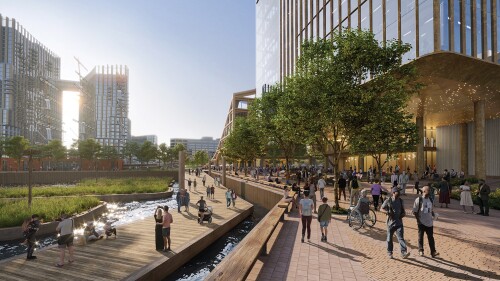
Responding to future climate change scenarios, the ground plane at the resilient Clippership Wharf development in East Boston is elevated, accounting for future sea level rise. The redevelopment of a historic wharf in East Boston, Clippership Wharf provides public access to the shoreline for the first time in more than 25 years and has been awarded LEED v4 Silver for Neighborhood Development.(Lendlease)
Out of the rising tides of climate change have emerged nimble projects that embrace floodwaters and shifts in thinking about design and construction.
Facing a million-dollar view of Biscayne Bay at Miami’s InterContinental Hotel in February, ULI panelists declared the concept of 100-year flood a throwback and U.S. federal flood maps an exercise in obsolescence.
“We can’t wait for the code to require resiliency . . . the idea of the 100-year storm is just old thinking,” said Miami architect Jacqueline Gonzalez Touzet. “We cannot be designing obsolete structures just because the code doesn’t require it yet.”
Baltimore architect Scot Foster with BCT Architects said that the lessons from the ULI panel translate worldwide to cities and towns grappling with water. He cited his own close-to-home experience when the Chesapeake Bay recently flooded a long-held Annapolis, Maryland, boat show.
“My takeaway is there’s a lot of learning lessons out there. I’m interested in what Miami is doing with this resiliency guideline they’re publishing in a few weeks,” Foster said. “Honestly, it has to be done now. I think as a country we’ve done a great job in the last 20 years of not addressing it, but now we have to.”
LEED Wharf Reclamation
In east Boston, developers navigated years of permitting so they could raise grade levels and buildings at their seven-acre (2.8 ha) Clippership Wharf project. Defined by water, it includes hundreds of apartments and condos, along with 10,000 square feet (929 sq m) of retail. The public realm features boardwalks, gathering places, and a kayak launch. Last year, it attained Leadership in Energy and Environmental Design (LEED) Silver for Neighborhood Development.
Nicholas Iselin, general manager of LendLease property and infrastructure group, said his team basically dismissed federal flood standards because they are so quickly outdated.
“FEMA didn’t even factor into our thinking about the project,” he told the audience. “We went so far beyond it.”
What distinguishes Clippership, other than exceeding standards for flood protections and affordable housing, is an innovative system of battening down the hatches. Leading up to potential flooding, two workers spend about an hour securing the wharf side of building lobbies, retail spaces, and garage entries.
“In 2018, we had two named storms with record storm surges, and during the first one, the pathway into the garage flooded the garage to 18 inches [46 cm] and there was lots of pumping,” Iselin said. “For the second storm, we plugged the holes and it performed just fine.”
Looking ahead, Iselin said he is scouting more sites where he can apply what he learned at Clippership.
Miami Beach Rising
When the San Francisco 49ers and Kansas City Chiefs traveled to Miami for the Super Bowl this year, it was the sugar sand beaches, promenades, and art deco hotels of Miami Beach that players talked about.
Poised just a few feet above sea level, the celebrated postcard playground has been working to save itself from rising tides in a town where resilience has supplanted sustainability as the buzz word.
The shift started a decade ago when the island city faced continuous sunny-day flooding. Officials responded with an expensive plan to raise streets. Now, those higher roads are passable—even during a hurricane—but some of the houses lining those roads are below sidewalks.
Thomas Mooney, Miami Beach planning director, said that raising roadways is a mere Band-Aid in the big picture of rising ocean levels.
For the longer view, owners are raising below-grade buildings and installing water storage at their base. The city works with developers on swales, cisterns, and pumping systems. It assembled a “dream team” of experts to set new standards intended to protect its stock of historic architecture.
“We are going to have to look at this on our own and, at least for the foreseeable future, not look for any help from the state or federal government,” Mooney said.
Miami Beach’s new plan, which ULI’s Advisory Services has worked with the city on, is due out in the coming weeks.





